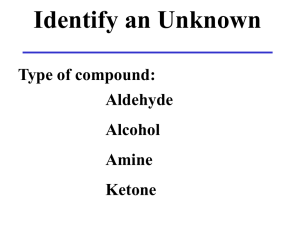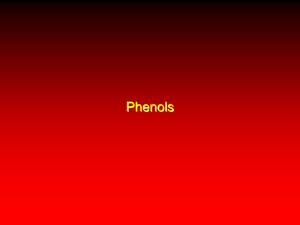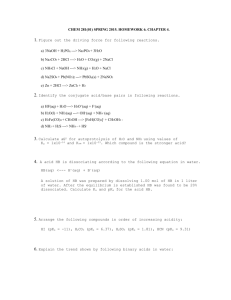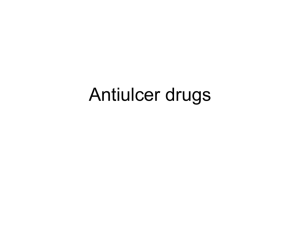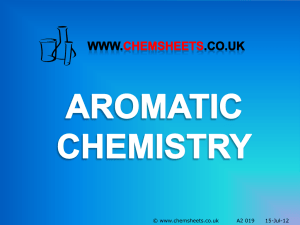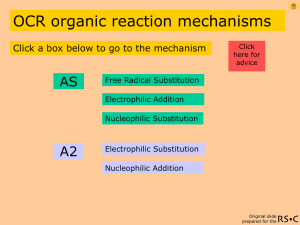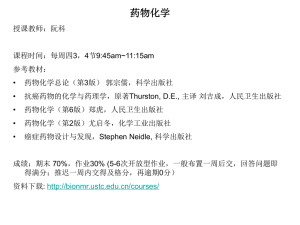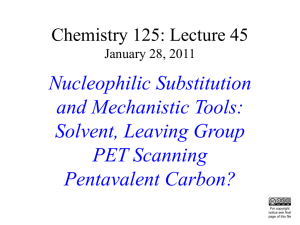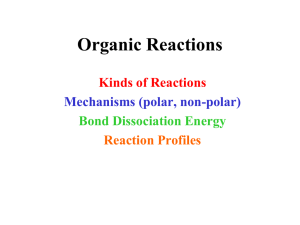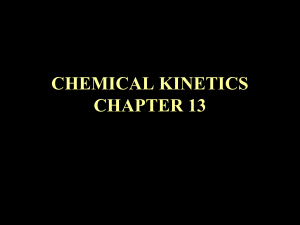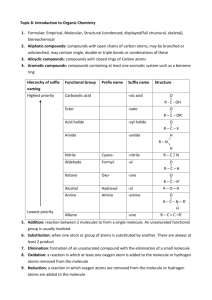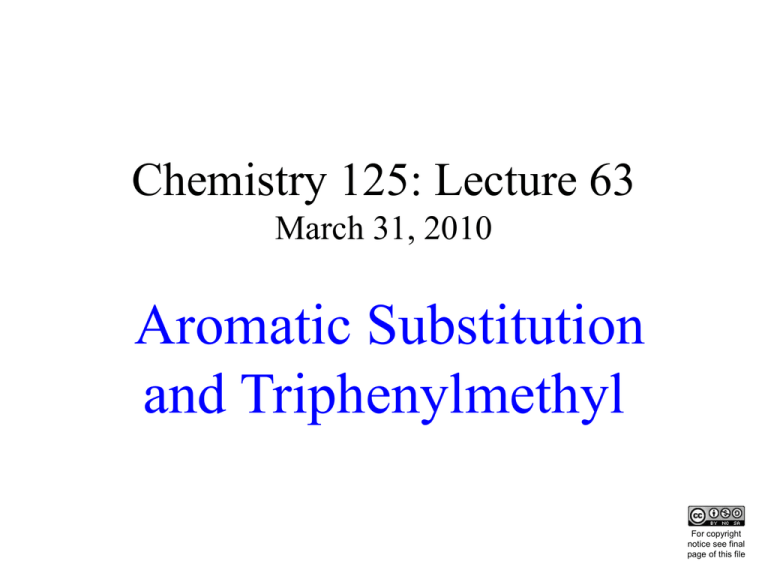
Chemistry 125: Lecture 63
March 31, 2010
Aromatic Substitution
and Triphenylmethyl
This
For copyright
notice see final
page of this file
Diazotization I: N-Nitrosoamine (sec. 14.7)
at modest acidity
[PhNH22]]000
Rate [HONO]22 [PhNH
H-O-N=O
(nitrous acid)
rate-determining step
Slow
an important intermediate for aromatic synthesis
Slow
How to make it?
N2 is a spectacular leaving group.
Why not cut out
the middle man?
Fast
(anhydride)
Diazotization II: Higher Acidity
at higher acidity
Rate [HONO]2 [PhNH2]11
rate-determining step
Slow
Slow
depends on
small concentration
of free aniline
H
+
Slower
Fast
“allylic”
proton
Diazotization II: Higher Acidity
Allylic Rearrangement
Complex!
Shifts of rate-determining step,
and even of mechanism.
Many roads lead to
benzenediazonium.
increasing acidity
Diazonium Uses (sec. 14.7)
Diazonium Uses (sec. 14.7)
Good way to
make toluene?
What use
is this
reaction?
Preparation Problems
NO2
NO2
Cl
NO2
Cl2
HNO
Cl2 3
FeCl3
HFeCl
2SO43
“reduction”
(Zn/HCl?)
(Cl+ FeCl4-)
Cl
Cl
+
NH2
N2 Cl-
OH
HONO
H2O
(NaNO2/HCl)
100°C
Cl
Cl
diazonium salt
or :
Hal
CN
NO2
H
Cl
both o,p-directing!
Yale ‘98S
wrong group?
wrong place?
Indirect Synthesis
NO2
HNO3
CH3Cl
H2SO4
AlCl3
CH3
CH3
“reduction”
(Zn/HCl)
O
stronger
o,p-director
CH3C NH2 than CH
H3C
CH3
H3PO2 !
+
N2 ClCH3
H3C
CH3Cl
HONO
AlCl3
(NaNO2/HCl)
CH3
CH3
CH3
O
CH3C NH2
3
if necessary
H3C
CH3
CH3
Nucleophilic Aromatic Substitution
NO2
NO2
Slow
Step
activated by
two NO2
groups
activated
by F
NO2
F
F
H2N-R
Sanger’s
Regent
NO2
NO2
NHR
+
H
Why F?
(generally a poor
leaving group)
NO2
HN-R
Used to visualize
fragments with
exposed amine
groups in 2D
chromatography.
Amino acid sequence
Identify the amino acid
of insulin (1955)
1958 Nobel Prize to also won 1980 Nobel at the end of a chain
Frederick Sanger for DNA sequencing! or fragment of a chain
NAD+ NADH (p. 679)
(closely enough balanced to run both ways)
key molecules in biological
Oxidation
(H acceptor)
&
Reduction
(H donor)
Benzylic Reactivity - Anion - pKa
H2C=CH-CH2-H
pKa = 43
~107 Ka Alkyl-H
(sec. 13.12)
~9 kcal/mole
from allylic stabilization
PhCH2-H
pKa = 41
~109 Ka Alkyl-H
~12 kcal/mole
from benzylic
Ph2CH-H
pKa = 33.5
~108 Ka PhCH2-H ~11 kcal/mole
from 2nd benzylic
Ph3C-H
pKa = 31.5
102 Ka Ph2CH-H
~3 kcal/mole
from 3rd benzylic
Steric hindrance in
triphenylmethyl causes
twists that reduce
overlap with 2pC by 25%
from diphenylmethyl.
(C6 H5 )3
C
Triphenylmethyl
Free Radical
110 years old
b. Elizabetgrad, Ukraine (1866) Chicago (1884) University of Michigan (1886)
Transcript
Metallurgy
Geology
French
Chemical
& Physics
Math
Rhetoric
Literature
Mineralogy
Logic
in German
Scientific
Psychology
& French
Free-Hand
Drawing Chemistry
Speaker at Dedication of SCL (1923)
After freshman year
Gomberg averaged
MG
9.5 Chemistry
Labs per Week.
as Student
(not hours!)
2/3 of them were
Analytical
(no spectroscopy)
Gomberg in the Analytical Laboratory
"Moses
Gomberg
was Thiele's
in beautiful
the student
"This brilliant
Experiment,
onecoworker
of the most
in laboratory.
organic
He
was very
andfew
modest,
kept
entirely
himself,
chemistry
andreserved
one
which
people
credited
at to
first,
gave and
great
Munich
Johannes
Thiele
never chatted
in or out
of would
the
laboratory.
Some
years
later the
impetus
to chemistry
and
have
worthy
of any
age
31
Adolf
v.been
Baeyer
1896
work he carried out in the United States on the triphenylmethyl
distinction."
age 61
radical, a case of trivalent carbon, became famous."
R. Willstätter
Moses Gomberg
R. Willstätter
age 30
age 24
Thiele & Heuser (January 1896)
Hydrazine Derivatives of Isobutyric Acid
CH3
CH3
CH3
C N N C
CH3
CN
CH3
CN
AIBN
CH3
C
CH3
C
CH3
CN CN
50%
Gomberg (Ann. 300, 59) Under the sponsorship of
Prof. Thiele I have followed up these reactions...
Victor Meyer 9/8/48 - 8/8/97
“Geliebte Frau! Geliebte Kinder!
Lebt wohl! Meine Nerven sind
zerstört; ich kann nicht mehr.”
Third Term
Heidelberg
with
Victor Meyer
(1848 - 1897)
who had
introduced
the idea of
Steric
Hindrance
Tetraphenylmethane (1897)
“I have tried to solve this problem
in a completely different way.”
Ph
Friedel-Crafts
Ph N Nor C
Ph2Mg
Ph
8g
Ph
?
110°
Cu
Ph
Ph C
Ph
Ph
0.3 g
Solubility
Analysis : C 93.32 (93.75) H 6.36 (6.25)
100 mg for Mol. Wt. : 0.289°
306 (320 calc.)
(by solvent b.p. elevation)
Back in Ann Arbor (1898-9)
Confirmed Mol. Wt. 0.285°
Prepared O2N-
318 (320 calc.)
- 4C (99.5% yield)
“Unlike the trinitrotriphenylmethane… it does
not dissolve in sodium ethylate, nor does it give
any coloration…”
OHow
- 3C-HO2
2N- about
EtO
N-
O2N-- 3 C-C
--NO
C + EtOH
?
3
2 3
Prepared "Hexaphenylethane"
Ph3C-Cl
Zn
O2
PhPh
3CO-OCPh
3C-CPh3 3
( C+H = 93.82 )
C+H = 93.97 , 94.20 , 94.00 , 94.57%
from first 4 methods.
Reported more than 17 methods.
Prepared authentic peroxide from Na2O2 .
Prepared hydrocarbon in CO2 atmosphere
using special apparatus with ground glass joints.
Free Radical! (1900)
Highly “Unsaturated” (O2, Cl2, Br2, I2!)
Launched an American Century of Chemistry
October, 1900
End of Lecture 63
March 31, 2010
Copyright © J. M. McBride 2010. Some rights reserved. Except for cited third-party materials, and those used by visiting
speakers, all content is licensed under a Creative Commons License (Attribution-NonCommercial-ShareAlike 3.0).
Use of this content constitutes your acceptance of the noted license and the terms and conditions of use.
Materials from Wikimedia Commons are denoted by the symbol
.
Third party materials may be subject to additional intellectual property notices, information, or restrictions.
The following attribution may be used when reusing material that is not identified as third-party content:
J. M. McBride, Chem 125. License: Creative Commons BY-NC-SA 3.0

